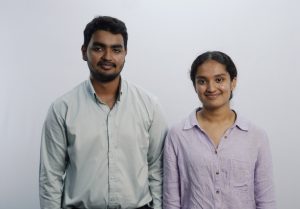
Warts caused by the human papillomavirus (HPV), enter the body to form bumps on the transdermal layer of the skin which may need removal as it could be harmful. One way of doing this is by injecting drugs, but transdermal drug delivery is a big challenge in India as it isn’t very efficient, or is extremely expensive. One survey found it affected 3.5 million people each year, and as warts spread rapidly and can be dangerous, it is seen that many people left it untreated. Anees, studying at Yenepoya Pharmacy College and Research Center, and Aganya who studies at Aloysius Degree College, were asked to come up with a more economical and practical micro dispenser that can be used in a user-friendly manner.
They first started their research by meeting the stakeholders who proposed this problem statement. They tried to understand what exactly they were expected to do, and how they were supposed to derive an answer as this was a new area of medicine that Anees and Aganya hadn’t explored yet. Dr Ramesh Bhat, head of the dermatology department at Fr Mullers, had written a case study in 2007, where he stated that acid treatment is the most efficient and economical method to remove warts, and when they asked him why he got back to this problem statement 10 years later, his answer was that he noticed a lack of collaboration between doctors and engineers, which restricted the development of new machines in the healthcare industry in India. When he heard a program called InUnity was making students work with stakeholders across various sectors like finance, medicine, agriculture, and education, he realized he could find a cure for his study with the help of these engineers.
Going deeper in the study, they realized that the US and other High-Income countries (HIC) had developed products that could deliver the drug to the wart very effectively. Brands like Compound W® have made products that cost more than 1500 rupees, but because most warts require at least 4 treatments it is not very affordable in India, nor is it available anywhere.
One of the main aims they were trying to achieve was to make this delivery possible while making the micro dispenser affordable.
Another problem they were trying to solve apart from successfully injecting drugs into the wart, was also to ensure they wouldn’t need to come to the hospital every month as this wasn’t that big of an issue but is very dangerous if left untreated. Other methods included cryotherapy, which is used by applying vaseline and local anesthesia, but the disadvantage is that it is a very complicated method for such a simple problem.
As of now, India does not have an effective micro dispenser, and even if it is available, the chances of reappearance are high. For primary research, they studied a lot about what happens when the virus goes into the body, and how it spreads. They saw that most warts go away on their own, but warts caused by the HPV could be fatal as it can also cause cervical and oropharyngeal (throat) cancer.
They also studied the pathophysiology of the disease. After reading research papers, talking to more stakeholders and having discussions on how to build their prototype, they came up with about 50 ideas on how to make the drug delivery. For this, they needed to meet an expert who could review their ideas and give them their views and opinions. But trying to meet up with the doctors was actually a challenge…
The challenge they faced was contacting senior doctors because they had vast information on this subject but were very busy throughout the day. If they had a new idea that they wanted to convey, they would have to wait for 2-3 weeks until they could schedule a next appointment with the doctor and see if their idea could be deployed.
After they successfully figured out how to solve this issue they plan to advertise this problem among local regions. They will print over 10,000 pamphlets and distribute them around the town and by this they hope to make people aware of the seriousness of this disease and its impacts.
During the InUnity Valedictory Program held at Ocean Pearl, Mangalore, Anees and Aganya were presented as one of the outstanding teams in the cohort for their innovation and brilliance. Their aim of making the micro dispenser affordable was achieved as they assured us it would be between 150 to 200 rupees. They also got full assurance from Yenepoya Technology Incubator for further support and to take the project ahead.
They are still in the development stage of the prototype but they are certain that we will be able to see their products in the markets in a few months from now. Transdermal drug delivery is a massive issue these days and by developing this product Anees and Aganya have really inspired so many people that engineering and medicine could work alongside each other to help our society. This is a perfect example of how these 2 fields of science worked together in unity to create marvelous results.
